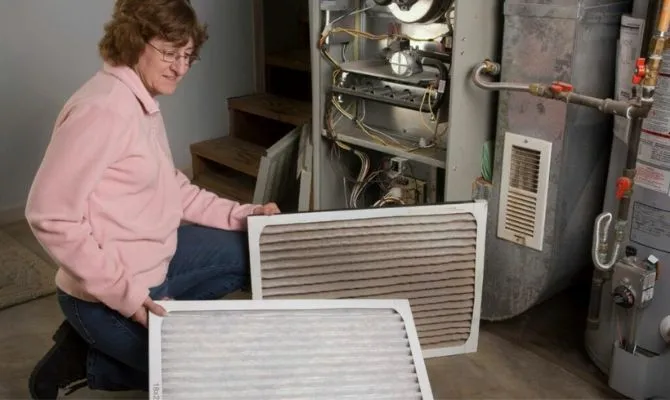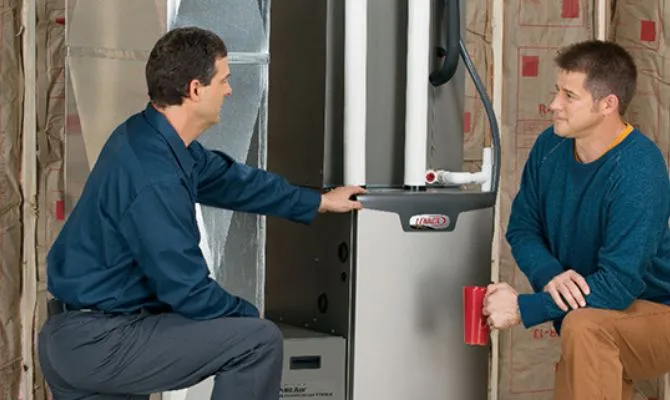It can be challenging to determine a set lifespan for a furnace, as there are many variables at play. On average, a furnace can last between 15 to 20 years with proper maintenance. However, the actual lifespan can vary depending on factors such as the quality of the unit, maintenance frequency, and usage.
In this article, we will provide you with information on the average furnace lifespan, what factors can impact its longevity, signs it’s time for a replacement, and tips for prolonging its life. Get ready to learn about the expected lifespan of a furnace and when it may be time for a change.
Furnace Lifespan: What is the Average Age of a Home Furnace?
Curious about the average lifespan of a gas furnace? Well, there are varying opinions on the subject. While some furnaces can last up to 40 years, this is a rare occurrence. Typically, furnaces last between 15 to 30 years. With regular annual maintenance, a furnace should easily last over 15 years. With great brands, like Lennox, you can comfortably anticipate 20 years.
Think of your furnace like a car – as it ages, it may require some basic repairs. However, if the furnace is out of warranty, some people opt to replace it even before a repair is needed. Others are willing to make repairs before upgrading to a new model.
Furnace Life Expectancy: Key Factors that Impact Your Furnace’s Longevity
INCORRECT FURNACE SIZING
Incorrect furnace sizing refers to when a furnace is not properly sized for the heating and air conditioning system of a home. A furnace that is too small will work harder to heat the home, leading to higher energy bills and reduced lifespan, while a furnace that is too large will cycle on and off frequently, also reducing its lifespan and making the home uncomfortable.
Proper furnace sizing takes into account factors such as the size of the home, the number of windows and doors, insulation levels, and local climate. If a furnace is not properly sized, it will not be able to heat the home efficiently and effectively, leading to increased energy costs and reduced lifespan.
To ensure proper furnace sizing, it’s best to consult with a certified heating and air conditioning professional. They will be able to assess your home’s heating needs and recommend the right sized furnace for your system.
POOR FURNACE INSTALLATION
Poor installation can have a significant impact on the lifespan of a gas furnace. When a furnace is not properly installed, it can cause a variety of problems that can affect performance and reduce the lifespan of the furnace.
Poor ductwork design, sizing, and sealing can restrict airflow, making it difficult for the furnace to heat the home effectively. Improperly installed venting and fuel lines can also cause problems, leading to increased energy costs, reduced performance, and a shorter lifespan for the furnace.
Inaccurate installation can also lead to safety hazards, such as carbon monoxide leaks, which can be deadly.
To ensure proper installation and maximize the lifespan of your furnace, it’s important to hire a certified and experienced heating technician. They will be able to properly install the furnace, design and install the ductwork, and make any necessary repairs to improve performance and prevent problems down the road.
LACK OF FURNACE MAINTENANCE
Lack of regular maintenance can have a major impact on the lifespan of a gas furnace. Regular maintenance helps to keep the furnace in good working condition, extending its performance and lifespan.
During routine maintenance, a certified heating technician will clean the furnace, inspect its components, and make any necessary repairs. This can help to catch small problems before they become bigger issues, preventing costly breakdowns and reducing the need for early furnace replacement.
Regular maintenance can also improve the energy efficiency of the furnace, helping to reduce energy bills and keep the home more comfortable.
It’s recommended to have annual furnace maintenance performed by a certified heating technician. They will be able to assess the condition of the furnace and make any necessary repairs, helping to extend its performance and lifespan. Failing to perform regular maintenance can result in a reduced lifespan for the furnace and higher energy costs over time.
EXTREME THERMOSTAT SETTINGS FOR YOUR FURNACE
Extreme thermostat settings, whether setting the temperature too high or too low, can have a negative impact on the lifespan of a gas furnace. When the thermostat is set too high, the furnace will work harder to maintain the temperature, potentially causing damage to the components and reducing its lifespan. Conversely, setting the temperature too low can cause the furnace to cycle on and off frequently, also leading to reduced performance and a shorter lifespan.
It’s recommended to set the thermostat between 60° and 80° Fahrenheit (15° to 26°Celsius) to avoid extreme temperature settings. This will help to ensure that the furnace runs efficiently and effectively, extending its lifespan and improving energy efficiency.
To maximize the lifespan of your furnace, it’s important to set the thermostat at a comfortable and energy-efficient temperature, and to avoid extreme temperature settings. By doing so, you can help to keep the furnace running smoothly and prevent damage to the components, leading to a longer lifespan for the furnace.
The Signs of an Imminent Furnace Failure
Your furnace, like all mechanical systems, will eventually reach the end of its useful life and need to be replaced. To avoid being caught in the cold with a suddenly defunct furnace, keep an eye out for the following warning signs:
- Increased frequency of service calls – If you find yourself calling for repair services more frequently, it may be a sign that your furnace is near the end of its life and starting to break down.
- Escalating repair costs – As a furnace gets older, repairs can become more expensive, especially if multiple parts need to be replaced. If your repair bills are growing, it may be time to consider replacing your furnace.
- Performance problems – If your furnace is blowing cold air instead of warm, or if it’s not heating your home evenly, it may be a sign that it’s on its last legs.
- Declining air quality – If you’re noticing a decrease in air quality, such as increased dust and allergens in your home, it could be due to a failing furnace that’s not functioning correctly.
- Uneven temperatures in your home – If some rooms in your house are significantly warmer or cooler than others, it could be a sign that your furnace is no longer operating efficiently and needs to be replaced.
- Increased noise – If you notice a new or increased noise coming from your furnace, it may indicate that some parts are starting to wear out and need to be replaced.
- High energy bills – A sudden increase in your monthly energy bills could be due to an aging furnace that’s no longer operating efficiently and is consuming more energy to heat your home.
In conclusion, keeping an eye out for these warning signs can help you prepare for a furnace replacement, avoiding a costly breakdown and the inconvenience of a winter without heat.
Maximizing the Life of Your Gas Furnace
To ensure that your gas furnace continues to run smoothly and efficiently for as long as possible, it’s important to maintain it regularly. Here are some tips for extending the lifespan of your furnace:
- Regular cleaning – Keeping the filters, motors, and heat exchanger free from dirt, dust, and other debris will help prevent them from clogging up and causing problems that could shorten the lifespan of your furnace.
- Replace air filters – Checking and cleaning your furnace air filter on a regular basis is an easy and effective way to maintain its performance and efficiency.
- Dual-fuel system – When you’re ready to replace your furnace, consider adding a heat pump to your setup. This will create a dual-fuel system, which will help reduce the workload on your furnace and extend its lifespan.
- Professional maintenance – Regular check-ups and cleanings by a qualified HVAC professional will help keep your furnace in top condition and prevent problems that could shorten its lifespan.
In conclusion, taking the time to maintain and care for your gas furnace can help extend its lifespan and ensure that it continues to provide reliable heating for your home. By following these tips, you can help prevent premature failure and keep your furnace running smoothly for many years to come.



